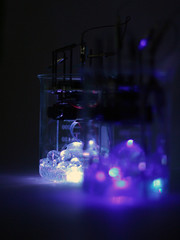 |
| Image via Wikipedia |
Obviously, everything on the Earth is solid, liquid or gas. Also, such as in a candle flame or a neon sign, it consists of a tiny amount of plasma. At least these states of matter seem to exist in these forms, because that is the way energy works. Energy is another state of matter, such as what happens when antimatter meets matter -- a terribly big explosion which leaves no ash behind but rapidly fleeing photons.
Mathematically, which I will not suffer the reader to engage, these states of matter are problematic, because they are inelegant and make clunking noises. Rather than beautiful smooth transitions from the ether of space to the immensely dense solids of frozen ices, there are clunking noises -- sudden changes from one state to another. There are a few extra clunky aspects to these things as well -- such as carbon dioxide ice directly "melting" to a gas. The closest thing to liquid carbon dioxide we can view would be at the surface of Venus, yet it is still a gas. Gases in the cores of stars, where immensely high pressure reigns, are so thick as to seem like solids.
I don't want to explain how such things happen, again not wishing to numb the reader with esoteric laws of physics and excessive mathematical exercises. It is merely an artistic observation.
 |
| Bit Blobs (Photo credit: Dr. Bleep) |
Computers deal with pieces of information called bits, which are packed into blobs called bytes or integers or floating point expressions, and then strung together in larger blobs and groups of blobs, sometimes called objects or sometimes called databases, or called a variety of other names at the whim of many programmers over the decades. There seem to be too many of those names, in my opinion, however that is the nature of humans. We like to put labels on things, and if someone else has already named something A, then someone else might rather call another thing B, or whatever. The important thing is that there are such things and they have labels created by humans. We have so many languages, too, so that the very same object can share a huge number of labels.
If everything was simply a single contiguous gas-like substance, such as space itself (devoid of matter), then we could not tell one part of it from any other. It is fortunate, instead, that we have bits of things that we can group and divide and give different names, just like the computer bits. The atoms and their constituent subatomic particles are not so homogeneous as computer bits, but can serve a similar purpose for the sake of argument. At some level of reality, where the actual "bits" of reality are found, one could view them as arbitrary sets arranged in groups of eight or sixty four, or whatever.
When we actually try to do that with reality, with various kinds of quarks, leptons, bosons and so forth -- it gets way too complicated, and the mathematics becomes gnarled -- not the neat digital math of computers, but the messy, goopy math of a sort that we are not truly able to define exactly. It may turn out that mathematicians of the future actually solve that problem, yet still cannot solve the harder problem of how all this fits in the greater meta-universe.
In our local universe, at least the parts we can actually sense and map, there are tremendously massive bags of bits, and we call them things -- stars, nebula, galaxies, clouds, planets, and so forth. We can make arbitrary groupings of atoms into various shapes, pools, balloons or whatever -- and never cease making new formations, each with a new name. We can make illusions of objects from illusions of bits that only exist electronically in a phantom world. We sometimes get so wrapped up in those virtual worlds of not-really-real bits that they become the reality our consciousness prefers to inhabit.
There is also the effects of such bits, which like the gravity from a distant, invisible star, can effect things in the real world. When computer bits of a certain pattern are arranged in appropriate registers, then motors can whir or colors can be formed or sounds can be emitted, and myriad other effects can be made to occur. The imaginary world of computer bits is not really ether, but formed from little wires and bits of crystals with electrons flowing about like liquids through pipes and valves. The gravity from a distant star is also a substance, supposedly made up of gravitons by some theories, but at least it does emit photons, so that it can effect us from such a distance by one method or another.
It may wind up sometime in the far distant future (another space-like thing, time) when nothing but a vast homogeneous bag of photons (or whatever) remains -- some immense number of bits, but each belonging to no group, none having any label, none having any effect on anything else, ever again. And perhaps even all of those will, after cooling to zero temperature, cease to be differentiated -- to condense into a single unit of nothingness, to swallow even time itself.
